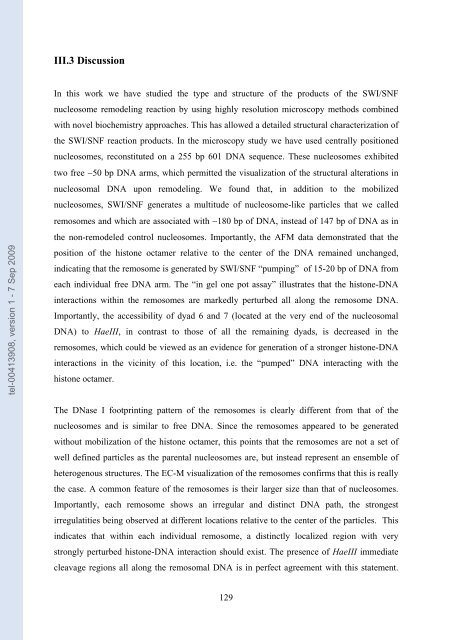Etudes sur le mécanisme de remodelage des nucléosomes par ...
Etudes sur le mécanisme de remodelage des nucléosomes par ...
Etudes sur le mécanisme de remodelage des nucléosomes par ...
Create successful ePaper yourself
Turn your PDF publications into a flip-book with our unique Google optimized e-Paper software.
tel-00413908, version 1 - 7 Sep 2009<br />
III.3 Discussion<br />
In this work we have studied the type and structure of the products of the SWI/SNF<br />
nuc<strong>le</strong>osome remo<strong>de</strong>ling reaction by using highly resolution microscopy methods combined<br />
with novel biochemistry approaches. This has allowed a <strong>de</strong>tai<strong>le</strong>d structural characterization of<br />
the SWI/SNF reaction products. In the microscopy study we have used centrally positioned<br />
nuc<strong>le</strong>osomes, reconstituted on a 255 bp 601 DNA sequence. These nuc<strong>le</strong>osomes exhibited<br />
two free ∼50 bp DNA arms, which permitted the visualization of the structural alterations in<br />
nuc<strong>le</strong>osomal DNA upon remo<strong>de</strong>ling. We found that, in addition to the mobilized<br />
nuc<strong>le</strong>osomes, SWI/SNF generates a multitu<strong>de</strong> of nuc<strong>le</strong>osome-like <strong>par</strong>tic<strong>le</strong>s that we cal<strong>le</strong>d<br />
remosomes and which are associated with ∼180 bp of DNA, instead of 147 bp of DNA as in<br />
the non-remo<strong>de</strong><strong>le</strong>d control nuc<strong>le</strong>osomes. Importantly, the AFM data <strong>de</strong>monstrated that the<br />
position of the histone octamer relative to the center of the DNA remained unchanged,<br />
indicating that the remosome is generated by SWI/SNF “pumping” of 15-20 bp of DNA from<br />
each individual free DNA arm. The “in gel one pot assay” illustrates that the histone-DNA<br />
interactions within the remosomes are markedly perturbed all along the remosome DNA.<br />
Importantly, the accessibility of dyad 6 and 7 (located at the very end of the nuc<strong>le</strong>osomal<br />
DNA) to HaeIII, in contrast to those of all the remaining dyads, is <strong>de</strong>creased in the<br />
remosomes, which could be viewed as an evi<strong>de</strong>nce for generation of a stronger histone-DNA<br />
interactions in the vicinity of this location, i.e. the “pumped” DNA interacting with the<br />
histone octamer.<br />
The DNase I footprinting pattern of the remosomes is c<strong>le</strong>arly different from that of the<br />
nuc<strong>le</strong>osomes and is similar to free DNA. Since the remosomes appeared to be generated<br />
without mobilization of the histone octamer, this points that the remosomes are not a set of<br />
well <strong>de</strong>fined <strong>par</strong>tic<strong>le</strong>s as the <strong>par</strong>ental nuc<strong>le</strong>osomes are, but instead represent an ensemb<strong>le</strong> of<br />
heterogenous structures. The EC-M visualization of the remosomes confirms that this is really<br />
the case. A common feature of the remosomes is their larger size than that of nuc<strong>le</strong>osomes.<br />
Importantly, each remosome shows an irregular and distinct DNA path, the strongest<br />
irregulatities being observed at different locations relative to the center of the <strong>par</strong>tic<strong>le</strong>s. This<br />
indicates that within each individual remosome, a distinctly localized region with very<br />
strongly perturbed histone-DNA interaction should exist. The presence of HaeIII immediate<br />
c<strong>le</strong>avage regions all along the remosomal DNA is in perfect agreement with this statement.<br />
129

















